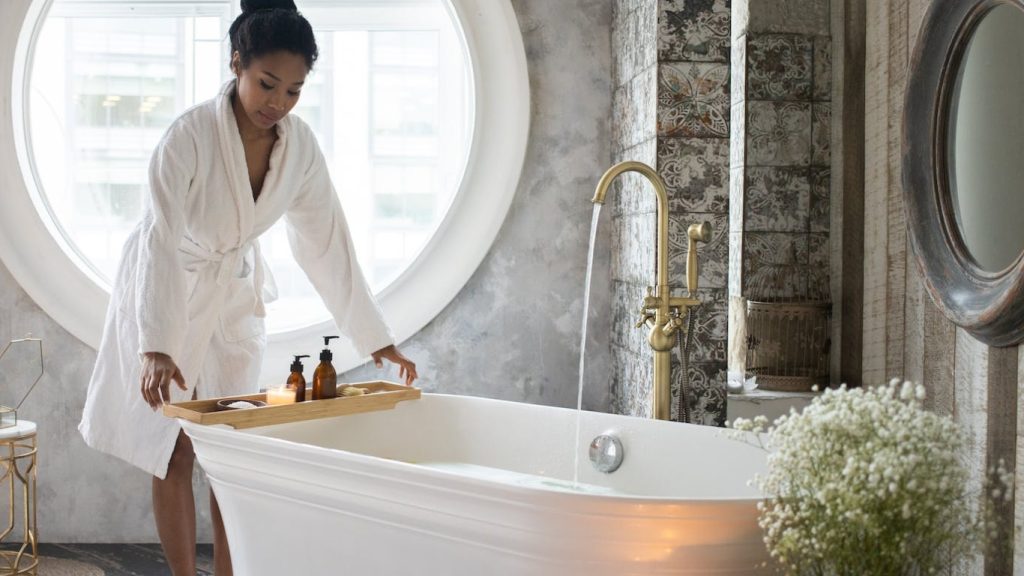If you’ve ever taken an unrestrained plunge into a pool full of chilly water, you’re aware that your brain detects the sudden decrease in your skin’s temperature as an undesirable jolt to its system. While your body will ultimately adjust itself to its aquatic environs, occasionally the pain continues for several minutes, making water an unpleasant location to loiter.
Since moderate discomfort typically accompanies recreational waters that are just mildly chilly, how on earth could anyone be cajoled into plunging themselves into icy water for the sake of health? The reality is that there are a number of claimed benefits to willingly submitting yourself to a bone-chilling cold plunge bath—a practice that is only rising in popularity.
One of the main benefits is that it is believed to improve circulation and boost the immune system. The shock of the cold water causes blood vessels to constrict and then dilate, which can improve blood flow throughout the body. Additionally, cold water is thought to stimulate the release of endorphins, providing a natural mood boost and increased energy levels. While it may seem counterintuitive, many people find that the initial discomfort is well worth the long-term benefits of regular cold plunges.
What Is a cold plunge?
A cold plunge is a form of hydrotherapy that involves immersing the body in cold water for a short period of time. It is often used as a therapeutic practice to promote physical and mental well-being. The concept of cold plunging has been around for centuries and is found in various cultures around the world. Many people believe that a cold plunge helps to reduce inflammation and improve circulation in the body. Some individuals also use it as a form of stress relief and to boost their immune systems. Although it may seem uncomfortable at first, the invigorating experience of a cold plunge can leave you feeling refreshed and rejuvenated.
What You Need to Build Your Own Cold Plunge
To build a cold plunge, there are a few essential items you will need. Firstly, you will need a suitable location for your plunge. This can be an outdoor space, such as a backyard or garden, or an indoor area, like a basement or garage. Additionally, you will need a container or structure to hold the cold water, such as a large bathtub, a stock tank, or a custom-built plunge pool. The size of the container will depend on the available space and the number of people who will be using it. Once you have chosen a location and a container, there are a few other items you will need to set up your plunger.

Credit: Monstera Production / Pexels
[Read More: How To Lose Weight With Pots Syndrome]
These include a source of cold water, such as a garden hose or access to a nearby water supply, as well as a way to fill and drain the container, such as a pump or faucet. It is also important to consider safety measures, such as installing a non-slip surface around the plunge area and ensuring there are proper steps or ladders for easy entry and exit. Lastly, don’t forget to have towels or robes nearby for drying off after the plunge.
- Freezer Chest
- Caulking Gun with Marine Sealant
- Flex Seal (or similar)
- Temperature Controller
- A Convenient Water Source
How to Make Your Own Ice Bath, Step-by-Step
To start your DIY cold plunge, you will need to gather the necessary materials. This includes a large container or tub that can hold enough water for you to fully submerge yourself in, as well as ice or cold water to lower the ice bath temperature. Additionally, you may want to consider adding Epsom salt or essential oils to enhance the experience and provide added benefits for your body. Once you have all the materials ready, it’s time to begin the step-by-step process of creating your own invigorating cold plunge.
Step 1: Purchase a Freezer Chest
Any freezer chest will do as long as it’s of appropriate volume and has proportions that allow you to lie down with your head above the water. In this situation, you’ll require a freezer chest with a volume of at least seven cubic feet, which translates to a little over 50 gallons of water.
At an in-store discount, an appropriate freezer chest may potentially be obtained in the range of 200 dollars; however, you can probably find a used freezer chest for significantly less.
Step 2: Caulk the Seams
Your first step toward converting your freezer chest into a cold plunge will be to get your hands on a caulking gun to seal any gaps. This will require the application of marine sealant to guarantee that your caulk is sufficient to survive repeated exposure to water. You will also want to apply caulk to any gaps in the area around the drain plug without actually sealing the drain plug fully.
Step 3: Spread the Sealant
Once the caulk has fully dried, your next step will be to put a coat or two of sealant over the interior of the freezer chest if you desire to be especially vigilant about limiting leaks. Whether you choose Flex Seal or a comparable sealer, you’ll want to be careful not to put the sealant directly over the drain stopper.
In this manner, you will keep your easiest technique of dumping out the filthy water from earlier immersions before refilling it with new water.
Step 4: Install Your Temperature Controller
Now that your freezer chest has been suitably sealed off, the next remaining step is to install a temperature-controlling device. First, put the temperature controller into an electrical outlet, then connect your freezer chest to the temperature controller.
Next, put the probe attachment of the temperature controller into the freezer. From there, the temperature controller will keep the temperature of your water at your set level.
Step 5: Fill Your Cold Plunge With Water
Now that everything is in place, what was once an average freezer chest has undergone a full transformation into an acceptable cold plunge. The only thing left to do is fill it with water, which is most readily achieved by using a garden hose, especially if your cold plunger is set up outdoors.
Ice Bath Benefits Weight Loss
Ice baths diy, or cold water immersion, are not typically considered a primary method for weight loss. While they have several potential health benefits, weight loss primarily depends on factors such as diet, exercise, and overall energy balance. That said, there are some indirect ways in which ice baths might have a minor impact on weight management.
Caloric Expenditure
Ice baths may slightly increase caloric expenditure. When the body is exposed to cold temperatures, it works harder to maintain its core temperature, which can lead to burning more calories. However, the number of calories burned during an ice foot bath is minimal and may not significantly contribute to weight loss. Other factors such as diet and exercise are still more important for managing weight.
Metabolism
Cold exposure can stimulate the activation of brown adipose tissue (brown fat), which helps burn energy to generate heat. While this may have a minor effect on metabolism, it’s not a primary strategy for weight loss.
Appetite Control
Some people find that cold exposure can reduce appetite temporarily. This may lead to reduced calorie intake in the short term, which could contribute to weight management. However, the effect is often modest and temporary.
Recovery and Exercise
Ice baths are often used as a recovery strategy for athletes and active individuals. By reducing inflammation and muscle soreness, they may indirectly support regular exercise, which can contribute to long-term weight management.
It’s important to note that relying solely on ice baths for fat loss is neither practical nor effective. Weight loss and management require a comprehensive approach that includes a balanced diet, regular physical activity, and sustainable lifestyle changes.
Ice baths should be used as a complementary strategy to support recovery, reduce inflammation, and possibly enhance overall well-being, rather than as a primary method for weight loss. Always consult with a healthcare professional or fitness expert before incorporating cold water immersion into your routine, especially if you have underlying health conditions.
FAQs
Can you make your own cold plunge?
Yes, it is possible to make your own cold plunge at home. Creating a cold plunge can be a great addition to your wellness routine, providing numerous health benefits.
Can you have an ice bath during pregnancy?
It is generally not recommended to have an ice bath during pregnancy. The extremely cold temperatures can cause vasoconstriction, which can restrict blood flow to the uterus and potentially harm the developing baby. Additionally, the sudden drop in body temperature can put stress on the mother’s cardiovascular system.
It is important for pregnant women to prioritize their comfort and safety, and there are other ways to manage discomfort or inflammation during pregnancy that do not involve ice baths. Consulting with a healthcare provider is always recommended before trying any new treatments or therapies during pregnancy. They can provide guidance and offer alternative options that are safe and suitable for the mother and baby.
What is the best ice bath temperature?
The best ice bath temperature is typically around 50 to 59 degrees Fahrenheit (10 to 15 degrees Celsius). This temperature range is considered optimal for reaping the benefits of ice baths without subjecting the body to extreme cold. However, it’s important to note that individual preferences may vary, and some athletes or individuals may prefer slightly colder or warmer temperatures for their ice baths. Ultimately, finding the right temperature for an ice bath is a matter of personal comfort and experimentation.
How long should I ice bath for?
The duration of an ice bath can vary depending on your tolerance and the purpose of the bath. Generally, it is recommended to start with shorter durations, such as 5 to 10 minutes, and gradually increase the time as your body becomes more accustomed to the cold. It is important to listen to your body and not push yourself too hard, as prolonged exposure to extreme cold can have adverse effects.
How many calories does a 30 minute cold bath burn?
The number of calories burned during a 30-minute cold bath can vary depending on various factors. While taking a cold bath does increase the body’s energy expenditure to regulate body temperature, it is important to note that the calorie burn is not significant compared to other forms of exercise. For example, a study found that taking a 30-minute cold shower burned approximately 62 calories.
However, it is worth noting that this number can vary depending on an individual’s weight, metabolism, and the temperature of the water. Therefore, it is best to focus on incorporating regular exercise and a balanced diet for effective calorie burning and overall health.



